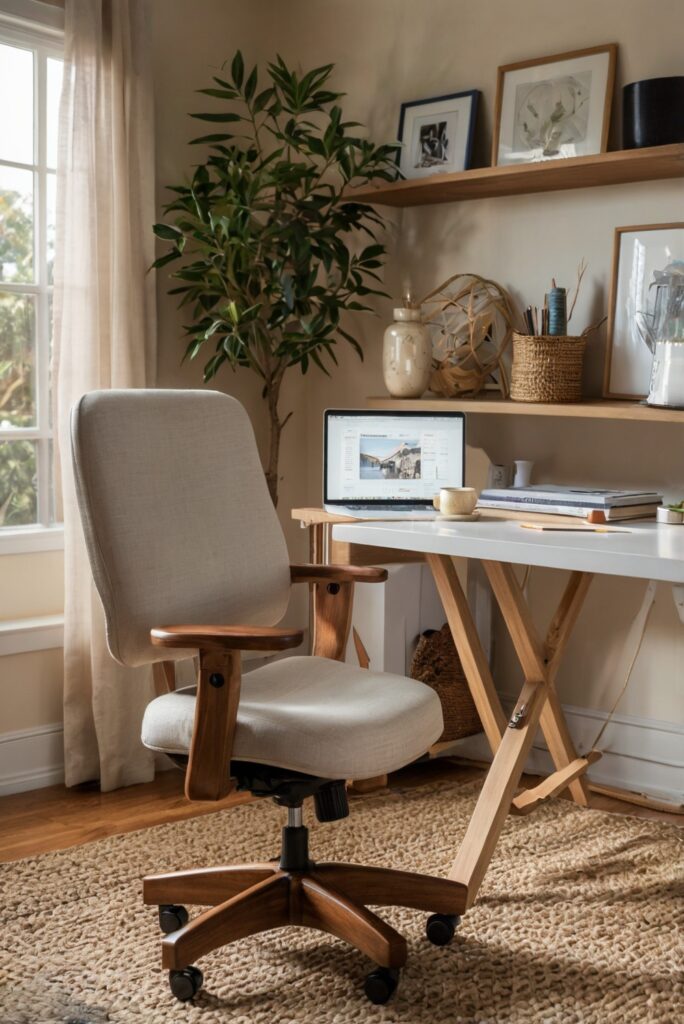Create a comfortable and functional home office setup by focusing on ergonomic chair placement for better posture. Learn how to optimize your workspace effectively.
To set up an ergonomic home office chair for optimal posture, ensure that your chair is at the appropriate height so your feet are flat on the ground and knees are at a 90-degree angle. Adjust the backrest to provide proper lumbar support and keep your spine aligned. Position your chair close to your desk to prevent slouching and maintain a neutral wrist position when typing. Adding a cushion or lumbar support can enhance comfort. Regular breaks and stretching exercises can help prevent fatigue and strain. Proper lighting and a clutter-free workspace contribute to a productive and visually pleasing home office environment.
Countries
– US
– UK
– Canada
– Australia
Table
| Feature | Description |
|———————|———————————————————————–|
| Height Adjustment | Ensures feet are flat on the ground and knees are at a 90-degree angle|
| Lumbar Support | Maintains proper spine alignment and reduces strain |
| Neutral Wrist Position | Minimizes wrist discomfort during typing |
| Regular Breaks | Enhances productivity and prevents fatigue |
How to Set Up an Ergonomic Home Office Chair for Optimal Posture?
Adjusting Seat Height:
To set up an ergonomic home office chair for optimal posture, start by adjusting the seat height. Your feet should be flat on the floor, with your knees at a 90-degree angle. This position helps distribute your weight evenly and reduces strain on your lower back.
Positioning Backrest:
Next, adjust the backrest of your chair to support the natural curve of your spine. The lumbar support should be positioned at the small of your back to maintain proper alignment. This helps prevent slouching and promotes good posture throughout the day.
Setting Armrest Height:
Ensure that your armrests are adjusted to the correct height to support your arms and shoulders. Your elbows should be at a 90-degree angle with your forearms parallel to the ground. This position helps reduce strain on your neck and shoulders and promotes a relaxed posture.
Importance of Proper Chair Setup:
Setting up your home office chair ergonomically is crucial for maintaining optimal posture and preventing musculoskeletal issues. Poor posture can lead to back pain, neck strain, and fatigue, affecting your overall well-being and productivity.
Tips for Maintaining Good Posture:
In addition to setting up your chair correctly, remember to take regular breaks, stretch, and move around to avoid prolonged sitting. Incorporating ergonomic accessories like a footrest or monitor stand can further enhance your workspace setup and promote better posture.
In conclusion, setting up an ergonomic home office chair for optimal posture is essential for your health and well-being. By following these tips and making small adjustments to your chair, you can create a comfortable and supportive workspace that promotes good posture and reduces the risk of discomfort and pain. Remember to prioritize your physical health while working from home to stay productive and pain-free.
What is the importance of setting up an ergonomic home office chair for optimal posture?
Setting up an ergonomic home office chair is crucial for maintaining good posture and preventing musculoskeletal issues. Poor posture can lead to back pain, neck strain, and other health problems. An ergonomic chair promotes proper alignment of the spine, reduces pressure on the back, and supports the natural curves of the body.
What are the key features to look for in an ergonomic home office chair?
When selecting an ergonomic chair, look for adjustable seat height, lumbar support, armrests, and a comfortable cushion. The chair should also have a breathable fabric to prevent sweating and promote airflow. A swivel base and wheels can enhance mobility and accessibility in the workspace.
How should the ergonomic home office chair be adjusted for optimal posture?
To achieve optimal posture, adjust the seat height so that your feet are flat on the floor and your knees are at a 90-degree angle. The backrest should support the natural curve of your spine, and the armrests should be positioned at a height that allows your shoulders to relax. Avoid slouching or leaning forward to maintain proper alignment.
What are some additional tips for maintaining good posture while using an ergonomic home office chair?
In addition to setting up the chair correctly, take regular breaks to stretch and move around. Use a footrest if needed to support your feet and reduce pressure on the legs. Practice proper typing and mouse techniques to prevent wrist strain. Consider using a monitor riser to position the screen at eye level for optimal neck alignment.
Are there any specific exercises or stretches that can help improve posture while sitting in an ergonomic home office chair?
Yes, incorporating exercises and stretches into your daily routine can help improve posture and reduce stiffness. Some beneficial stretches include shoulder rolls, neck stretches, and seated spinal twists. Strengthening exercises for the core and back muscles can also support better posture. Consider consulting a physical therapist for personalized recommendations.

